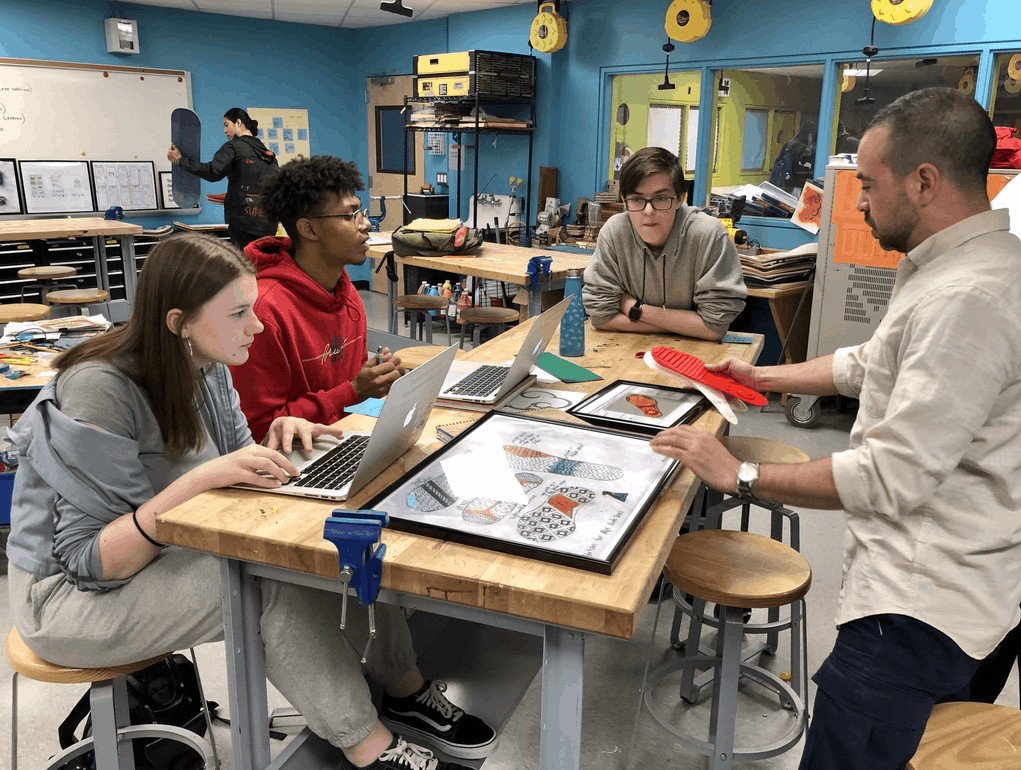What’s the Right High School Size and Structure?

High school is often a pivotal stage in a young person’s development, one where they formalize a sense of identity and make some early but important life decisions about careers and lifestyles. Context, relationships, and expectations matter a great deal during this period–but so do the experiences and environments of the institution–most of which were inherited from decades or even centuries gone by.
How to organize a high school? It’s a question being reconsidered as educators reflect on a year and a half of remote and hybrid learning and as society continues to change rapidly. There’s no single right answer to the question, solutions depend on goals and context.
What’s the right size for a high school?
For more than 100 years, the best public and private secondary schools have organized themselves into grade-level cohorts of 100-125 students. With a total enrollment of 400-500 students, a high school is small enough to maintain an intentional culture and large enough to offer a coherent curriculum.
The average American high school has about 850 students–twice the ideal but half of the stereotypical suburban high school.
Why did big comprehensive high schools become the norm?
Beginning in the 1970s suburban high schools often grew to more than 1,000 students. Offering more elective courses and extracurricular options, what became known as “shopping mall high schools” offered more choices. With the presumption of cost efficiency and growing interest in winning football teams, suburban schools, particularly in the south, often grew to more than 2,000 students in the 1980s and 1990.
What doesn’t work about big comprehensive schools?
While big schools can get it right (more on that below), there are seven typical challenges of big schools:
1. Big schools often became tracked with affluent white students in a college-bound course sequence and underserved students of color in career courses.
2. Big schools have a student-set culture. Without heroic leadership, big school cultures are a mixture of cliques that exclude many and don’t develop positive dispositions.
3. Big schools with a catalog of choices reduce the likelihood of sustained adult relationships, reduce curricular integration and coherence, reduce a sense of community, and with it a sense of safety, belonging, and attachment.
4. Big schools are inefficient. Big schools actually produced diseconomies of scale (above about 600 students) requiring more administration, more security, and more transportation–all increasing the percentage of non-teaching staff.
5. Big schools dampen participation. Scale and consolidations were frequently fueled by zeal for competitive sports but it often comes at the cost of participation. Big schools typically have lower rates of participation in extracurricular activities as they become larger and more selective.
6. Big schools are less responsive. It’s hard for big schools to incorporate student voice in decision-making. Size can make them less agile when changes are needed.
7. Big schools damage rural communities. Several thousand small rural high schools were closed in the last four decades. This consolidation into big regional schools initiates a death spiral for many communities.
Can small schools support personalization and personal interests?
Every high-performing charter school network in the country has high schools of 400-500 students with a coherent college preparatory curriculum. Examples include Achievement First, Aspire, Basis, DSST, Green Dot, Harmony, IDEA, KIPP, Noble, Summit, Uncommon, Uplift, and YES.
The 300 high schools of New Tech Network, EL Education, and High Tech High are schools of about 400 students that feature a coherent team-taught course of study that supports personalization through projects. Rather than a large number of elective courses, students at these deeper learning schools explore and express interests through project-based learning.
In the School District of Philadelphia, the faculty of Science Leadership Academy has shared instructional values– including inquiry, research, collaboration, presentation–that are evident in every classroom. It is difficult to create the same level of fidelity to a sophisticated learning model in a large comprehensive school.
What are the benefits of small schools on shared campuses?
New York has a 50-year tradition of small public and private high schools. Beginning in 1995 with the Julia Richman Education Complex, large comprehensive high schools were closed and replaced with several small schools that share common space and extracurricular activities. New high schools opened between 2000-2006 often doubled the graduation rate of the schools they replaced and performed better than remaining comprehensive high schools.
Over the last 30 years, more than 1,000 career academies were formed as semi-autonomous schools in shared facilities. Learners benefit from strong sustained relationships, a coherent curriculum, and related work-based learning experiences–as well as large campus extracurricular activities. Academies supported by NAF and ConnectEd have high graduation and college-going rates.
Da Vinci Schools in Los Angeles features three small themed high schools–Design, Communications, and Science–in a shared facility. Each school has three career pathways in small supportive environments. The three schools share common spaces and activities including music and performing arts, and a robust athletics program. Da Vinci represents the best features of small career-focused schools and large comprehensive schools.
What’s next in personalization?
For hundreds of years, high schools have been organized around a series of courses required for graduation. As schools focus more on essential skills and meeting the needs of individual students, these content building blocks can become confining artificial constraints. A few innovative small schools including Purdue Polytechnic High in Indianapolis and One Stone in Boise organize learning skill sprints, advisory groups, and projects. Every learner has a learning journey that combines individual skill building with team projects and the support of a coach and advisory cohort.
The Superintendent’s Association recently published Learning 2025, a report encouraging co-authored learning journeys. That means more voice and choice for learners–less about a big catalog of courses and more about the ability to tailor learning pathways that combine the right level of communication and problem-solving experiences with projects on topics that are important to the learner and the community.
It’s likely that as capacity is built to support individual and cohort learning journeys, that the size of schools will become less relevant–as the point of coherence moves to the individual learner, it is less necessary to rely on a course sequence or a school model to be the unifying factor.
Can big schools get it right?
Yes, but it takes four strong elements that borrow from the lessons of good small schools. First is an intentional culture rooted in shared values–and it takes committed and sustained leadership in a big school. Shared values must be evident in climate, communication, curriculum–they must be observed, heard, experienced every day.
Second, the use of small units–houses, academies, or microschools–can promote strong relationships and a sense of belonging and attachment. While these structures may limit elective options, they support deeper learning through integration and application.
Third, strong advisory programs provide a home base for performance and growth monitoring, skill-building, and postsecondary planning. A multi-year advisor relationship is key (see core and optional advisory functions).
And fourth is a system of integrated and tiered supports (often coordinated through the advisory system). Turnaround for Children notes that “Tier 2 and 3 supports must be provided in ways that are responsive to the often complex needs of students who experience trauma and adversity.”
Small schools are no guarantee for a compelling, coherent, personalized high school experience but big schools make it a real challenge.
Some suggest the future is ecosystems of learning opportunities that, with the aid of an advisor (and a few good apps), come together for individual learners–and that may be the best answer to the question of how to organize a high school.
For more, see:
- 101 Top School and Charter Networks
- Better Together: Why Schools Should Work in Networks (podcast with Lydia Dobyns)
This post was originally published on Forbes.
Stay in-the-know with innovations in learning by signing up for the weekly Smart Update.








0 Comments
Leave a Comment
Your email address will not be published. All fields are required.